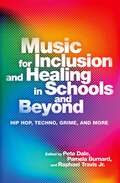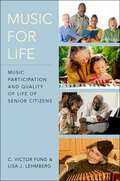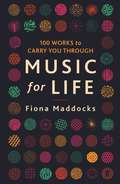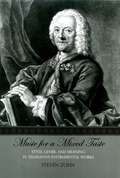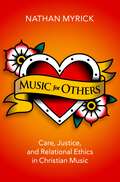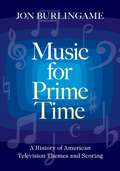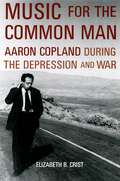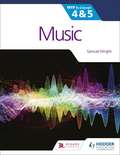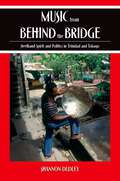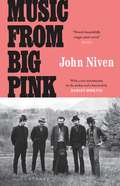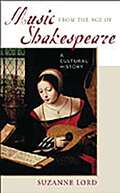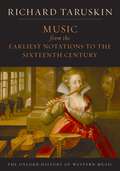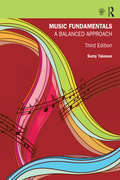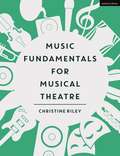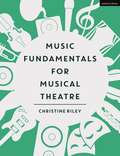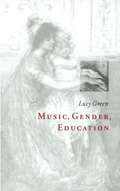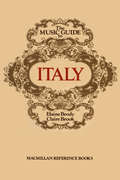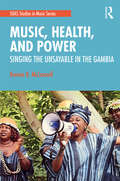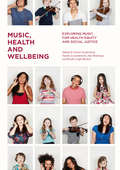- Table View
- List View
Music for Inclusion and Healing in Schools and Beyond: Hip Hop, Techno, Grime, and More
Contemporary popular musics such as hip hop, techno, grime, EDM, drill, house and so on are among the most listened to in the world and yet, typically, they are barely covered in the music classroom if at all. This needs to be better reflected in educational, cultural, and social terms. In wider society, these musics are often treated as if they are the causative for the social dysfunction that, in fact, they merely reflect. At the same time, projects, programmes and practices of such contemporary popular musics can and have supported wellness and healing. Editors Pete Dale, Pamela Burnard, and Raphael Travis Jr. argue that there is huge potential here for enhanced inclusion. Music for Inclusion and Healing in Schools and Beyond explains that when this music is included in the school curriculum or utilised in therapeutic contexts, huge leaps in healing and wellness can be achieved, as well as educational attainment and enjoyment in school contexts. This unique book seeks to account for those positive impacts, theorise them and help to extend and advance their impact. Contributing authors invite readers to re-think the possibilities and potentials for contemporary popular musics to gain the prestige that their actual popularity would suggest they should already command. The various contributors of this book are from diverse ethnic, social and academic backgrounds, and this title includes several chapters from practitioners who have not written about the work they do before now. Readers will learn not only about the impact of projects that utilize such music but also ideas about how that impact can best be measured.
Music for Life: Music Participation and Quality of Life of Senior Citizens
by C. Victor Fung Lisa J. LehmbergMusic for Life: Music Participation and Quality of Life of Senior Citizens presents a fresh, new exploration of the impact of musical experiences on the quality of life of senior citizens, and charts a new direction in the facilitation of the musical lives of people of all ages. Authors Fung and Lehmberg clearly define the issues surrounding music education, music participation, quality of life, and senior citizens, discussing the most relevant research from the fields of music education, adult learning, lifelong learning, gerontology, medicine, music therapy, and interdisciplinary studies. At the heart of the book is Evergreen Town, a retirement community in the southeastern U.S.A., that serves as the backdrop for three original research studies. The first of these is in two phases, a survey and a focus group interview, that examines the histories and rationales for the music participations and non-participations of community residents. The second and third case studies take an in-depth look at a church choir and a bluegrass group, two prominent musical groups in the community, and include the perspectives of the authors themselves as group members and participant-observers. Fung and Lehmberg conclude with a challenge for the profession of music education: to act on this research and on the current advances in the field, to enable all people to benefit from the richness of music as a substantial contributor to quality of life.
Music for Life: 100 Works to Carry You Through
by Fiona MaddocksHow does music reflect the key moments in our lives? How do we choose the works that inspire, delight, comfort or console? Fiona Maddocks selects 100 classical works from across nine centuries, arguing passionately, persuasively and at times obstinately for their inclusion, putting each work in its cultural and musical context, discussing omissions, suggesting alternatives and always putting the music first.
MUSIC FOR LIFE C: Music Participation and Quality of Life of Senior Citizens
by C. Victor Fung Lisa J. LehmbergMusic for Life: Music Participation and Quality of Life of Senior Citizens presents a fresh, new exploration of the impact of musical experiences on the quality of life of senior citizens, and charts a new direction in the facilitation of the musical lives of people of all ages. Authors Fung and Lehmberg clearly define the issues surrounding music education, music participation, quality of life, and senior citizens, discussing the most relevant research from the fields of music education, adult learning, lifelong learning, gerontology, medicine, music therapy, and interdisciplinary studies. At the heart of the book is Evergreen Town, a retirement community in the southeastern U.S.A., that serves as the backdrop for three original research studies. The first of these is in two phases, a survey and a focus group interview, that examines the histories and rationales for the music participations and non-participations of community residents. The second and third case studies take an in-depth look at a church choir and a bluegrass group, two prominent musical groups in the community, and include the perspectives of the authors themselves as group members and participant-observers. Fung and Lehmberg conclude with a challenge for the profession of music education: to act on this research and on the current advances in the field, to enable all people to benefit from the richness of music as a substantial contributor to quality of life.
Music for Others: Care, Justice, and Relational Ethics in Christian Music
by Nathan MyrickMusical activity is one of the most ubiquitous and highly valued forms of social interaction in North America (to say nothing of world over), being engaged from sporting events to political rallies, concerts to churches. Moreover, music's use as an affective agent for political and religious programs suggests that it has ethical significance. Indeed, many have said as much. It is surprising then that music's ethical significance remains one of the most undertheorized aspects of both moral philosophy and music scholarship. Music for Others: Care, Justice, and Relational Ethics in Christian Music fills part of this scholarly gap by focusing on the religious aspects of musical activity, particularly on the practices of Christian communities. Based on ethnomusicological fieldwork at three Protestant churches and a group of seminary students studying in an immersion course at South by Southwest (SXSW), and synthesizing theories of discourse, formation, and care ethics oriented towards restorative justice, it first argues that relationships are ontological for both human beings and musical activity. It further argues that musical meaning and emotion converge in human bodies such that music participates in personal and communal identity construction in affective ways-yet these constructions are not always just. Thus, considering these aspects of music's ways of being in the world, Music for Others finally argues that music is ethical when it preserves people in and restores people to just relationships with each other, and thereby with God.
Music for Others: Care, Justice, and Relational Ethics in Christian Music
by Nathan MyrickMusical activity is one of the most ubiquitous and highly valued forms of social interaction in North America (to say nothing of world over), being engaged from sporting events to political rallies, concerts to churches. Moreover, music's use as an affective agent for political and religious programs suggests that it has ethical significance. Indeed, many have said as much. It is surprising then that music's ethical significance remains one of the most undertheorized aspects of both moral philosophy and music scholarship. Music for Others: Care, Justice, and Relational Ethics in Christian Music fills part of this scholarly gap by focusing on the religious aspects of musical activity, particularly on the practices of Christian communities. Based on ethnomusicological fieldwork at three Protestant churches and a group of seminary students studying in an immersion course at South by Southwest (SXSW), and synthesizing theories of discourse, formation, and care ethics oriented towards restorative justice, it first argues that relationships are ontological for both human beings and musical activity. It further argues that musical meaning and emotion converge in human bodies such that music participates in personal and communal identity construction in affective ways-yet these constructions are not always just. Thus, considering these aspects of music's ways of being in the world, Music for Others finally argues that music is ethical when it preserves people in and restores people to just relationships with each other, and thereby with God.
Music for Prime Time: A History of American Television Themes and Scoring
by Jon BurlingameWith hundreds of interviews conducted over a 35-year span, this book is the most comprehensive history of television scoring to date. Music composed for television had, until recently, never been taken seriously by scholars or critics. Catchy TV themes, often for popular weekly series, were fondly remembered but not considered much more culturally significant than commercial jingles. Yet noted composers like John Williams, Henry Mancini, Jerry Goldsmith and Lalo Schifrin learned and/or honed their craft in television before going on to major success in feature films. Oscar-winning film composers like Bernard Herrmann, Franz Waxman and Maurice Jarre wrote hours of music for television projects, and such high-profile jazz figures as Duke Ellington, Dave Brubeck and Quincy Jones also contributed music to TV series. Concert-hall luminaries from Aaron Copland to Leonard Bernstein, and theater writers from Jerome Moross to Richard Rodgers, penned memorable scores for TV. Music for Prime Time is the first serious, journalistic history of music for American television. It is the product of 35 years of research and more than 450 interviews with composers, orchestrators, producers, editors and musicians active in the field. Based on, but vastly expanded and revised from, an earlier book by the same author, this wide-ranging narrative not only tells the backstory of every great TV theme but also examines the many neglected and frequently underrated orchestral and jazz compositions for television dating back to the late 1940s. Covering every series genre (crime, comedy, drama, westerns, action-adventure, fantasy and sci-fi), it also looks at music for animated series, news and documentary programming, TV-movies and miniseries, and how music for television has evolved in the era of cable and streaming options. It is the most comprehensive history of television scoring ever published.
Music for Prime Time: A History of American Television Themes and Scoring
by Jon BurlingameWith hundreds of interviews conducted over a 35-year span, this book is the most comprehensive history of television scoring to date. Music composed for television had, until recently, never been taken seriously by scholars or critics. Catchy TV themes, often for popular weekly series, were fondly remembered but not considered much more culturally significant than commercial jingles. Yet noted composers like John Williams, Henry Mancini, Jerry Goldsmith and Lalo Schifrin learned and/or honed their craft in television before going on to major success in feature films. Oscar-winning film composers like Bernard Herrmann, Franz Waxman and Maurice Jarre wrote hours of music for television projects, and such high-profile jazz figures as Duke Ellington, Dave Brubeck and Quincy Jones also contributed music to TV series. Concert-hall luminaries from Aaron Copland to Leonard Bernstein, and theater writers from Jerome Moross to Richard Rodgers, penned memorable scores for TV. Music for Prime Time is the first serious, journalistic history of music for American television. It is the product of 35 years of research and more than 450 interviews with composers, orchestrators, producers, editors and musicians active in the field. Based on, but vastly expanded and revised from, an earlier book by the same author, this wide-ranging narrative not only tells the backstory of every great TV theme but also examines the many neglected and frequently underrated orchestral and jazz compositions for television dating back to the late 1940s. Covering every series genre (crime, comedy, drama, westerns, action-adventure, fantasy and sci-fi), it also looks at music for animated series, news and documentary programming, TV-movies and miniseries, and how music for television has evolved in the era of cable and streaming options. It is the most comprehensive history of television scoring ever published.
Music for the Common Man: Aaron Copland during the Depression and War
by Elizabeth B. CristIn the 1930s, Aaron Copland began to write in an accessible style he described as "imposed simplicity." Works like El Salón México, Billy the Kid, Lincoln Portrait, and Appalachian Spring feature a tuneful idiom that brought the composer unprecedented popular success and came to define an American sound. Yet the cultural substance of that sound--the social and political perspective that might be heard within these familiar pieces--has until now been largely overlooked. While it has long been acknowledged that Copland subscribed to leftwing ideals, Music for the Common Man is the first sustained attempt to understand some of Copland's best-known music in the context of leftwing social, political, and cultural currents of the Great Depression and Second World War. Musicologist Elizabeth Crist argues that Copland's politics never merely accorded with mainstream New Deal liberalism, wartime patriotism, and Communist Party aesthetic policy, but advanced a progressive vision of American society and culture. Copland's music can be heard to accord with the political tenets of progressivism in the 1930s and '40s, including a fundamental sensitivity toward those less fortunate, support of multiethnic pluralism, belief in social democracy, and faith that America's past could be put in service of a better future. Crist explores how his works wrestle with the political complexities and cultural contradictions of the era by investing symbols of America--the West, folk song, patriotism, or the people--with progressive social ideals. Much as been written on the relationship between politics and art in the 1930s and '40s, but very little on concert music of the era. Music for the Common Man offers fresh insights on familiar pieces and the political context in which they emerged.
Music for the Common Man: Aaron Copland during the Depression and War
by Elizabeth B. CristIn the 1930s, Aaron Copland began to write in an accessible style he described as "imposed simplicity." Works like El Salón México, Billy the Kid, Lincoln Portrait, and Appalachian Spring feature a tuneful idiom that brought the composer unprecedented popular success and came to define an American sound. Yet the cultural substance of that sound--the social and political perspective that might be heard within these familiar pieces--has until now been largely overlooked. While it has long been acknowledged that Copland subscribed to leftwing ideals, Music for the Common Man is the first sustained attempt to understand some of Copland's best-known music in the context of leftwing social, political, and cultural currents of the Great Depression and Second World War. Musicologist Elizabeth Crist argues that Copland's politics never merely accorded with mainstream New Deal liberalism, wartime patriotism, and Communist Party aesthetic policy, but advanced a progressive vision of American society and culture. Copland's music can be heard to accord with the political tenets of progressivism in the 1930s and '40s, including a fundamental sensitivity toward those less fortunate, support of multiethnic pluralism, belief in social democracy, and faith that America's past could be put in service of a better future. Crist explores how his works wrestle with the political complexities and cultural contradictions of the era by investing symbols of America--the West, folk song, patriotism, or the people--with progressive social ideals. Much as been written on the relationship between politics and art in the 1930s and '40s, but very little on concert music of the era. Music for the Common Man offers fresh insights on familiar pieces and the political context in which they emerged.
Music for the IB MYP 4&5: MYP by Concept
by Samuel WrightA concept-driven and assessment -focused approach to Music teaching and learning.- Approaches each chapter with statements of inquiry framed by key and related concepts, set in a global context.- Supports every aspect of assessment using tasks designed by an experienced MYP educator.- Differentiates and extends learning with research projects and interdisciplinary opportunities.- Applies global contexts in meaningful ways to offer an MYP Music programme with an internationally-minded perspective.Also available Student eTextbook 9781510475533Whiteboard eTextbook 9781510475540Teacher's Pack 9781510478145
Music from behind the Bridge: Steelband Aesthetics and Politics in Trinidad and Tobago
by Shannon DudleyA symbol of Trinidadian culture, the steelband has made an extraordinary transformation since its origins-from junk metal to steel orchestra, and from disparaged underclass pastime to Trinidad and Tobago's national instrument. Now, Shannon Dudley gives the first discerning look at the musical thinking that ignited this transformation, and the way it articulates with Afro-Trinidadian tradition, carnival, colonial authority, and nationalist politics. Music from behind the Bridge tells the story of the steelband from the point of view of musicians who overcame disadvantages of poverty and prejudice with their extraordinary ambition. Literally referring to the poor neighborhoods nestled in the hills bordering Port of Spain to the East, "Behind the Bridge" is also a metaphor for conditions of social disadvantage and cultural resistance that shaped the steelband movement in the various Afro-Trinidadian communities where it first took root. The book further explores the implications of the steelband's "nationalization" in post-independence Trinidad and Tobago, and contemporary steelband musicians' preoccupation with the formally adjudicated annual Panorama competition. In discussing the intersection of musical thinking, festivity, and politics, this book connects important questions about the history of the steelband to general questions about the relation between popular culture and nationalism.
Music from behind the Bridge: Steelband Aesthetics and Politics in Trinidad and Tobago
by Shannon DudleyA symbol of Trinidadian culture, the steelband has made an extraordinary transformation since its origins-from junk metal to steel orchestra, and from disparaged underclass pastime to Trinidad and Tobago's national instrument. Now, Shannon Dudley gives the first discerning look at the musical thinking that ignited this transformation, and the way it articulates with Afro-Trinidadian tradition, carnival, colonial authority, and nationalist politics. Music from behind the Bridge tells the story of the steelband from the point of view of musicians who overcame disadvantages of poverty and prejudice with their extraordinary ambition. Literally referring to the poor neighborhoods nestled in the hills bordering Port of Spain to the East, "Behind the Bridge" is also a metaphor for conditions of social disadvantage and cultural resistance that shaped the steelband movement in the various Afro-Trinidadian communities where it first took root. The book further explores the implications of the steelband's "nationalization" in post-independence Trinidad and Tobago, and contemporary steelband musicians' preoccupation with the formally adjudicated annual Panorama competition. In discussing the intersection of musical thinking, festivity, and politics, this book connects important questions about the history of the steelband to general questions about the relation between popular culture and nationalism.
Music From Big Pink (33 1/3 Ser.)
by John Niven Barney Hoskyns'I love John Niven's writing – OBVIOUSLY – but came late to his first book, and was blown away by what vivid, delicate time-travel it is. Every The Band fan in the world MUST read it - it's like living in the music. Just smoky, ravishing magic' Caitlin MoranTimed to coincide with the fiftieth anniversary of the release of The Band's debut album, Music from Big Pink is John Niven's first novel – a heady blend of drugs, music, sixties counter-culture and intoxicating youth.Greg Keltner is a 23-year-old drug-dealer and wannabe musician. Through his eyes, we witness the gestation of a record that will go on to cast its spell across five decades – bewitching and inspiring artists as disparate as The Beatles, Eric Clapton, Wilco and Mercury Rev. Music From Big Pink is faction: real people like Richard Manuel, Rick Danko, Bob Dylan and Albert Grossman rub shoulders with fictional characters and imagined scenarios. Featuring a new foreword from Barney Hoskyns and a new introduction from the author, Music from Big Pink gives us a unique and vivid insight into the birth and legacy of The Band's debut album.
Music from the Age of Shakespeare: A Cultural History
by Suzanne LordThis book introduces every important aspect of the Elizabethan music world. In ten scrupulously researched yet accessible chapters, Lord examines the lives of composers, the evolution of musical instruments, the Elizabethan system of musical notation, and the many textures and traditions of Elizabethan music. Biographical entries introduce the most significant and prolific composers as well as the members of royal society who influenced Elizabethan musical culture. Both familiar and obscure instruments of the era are described with focus on their musical and social contexts. Various types of music are defined and illustrated, along with an explanation of the musical notation used during this era. Chapter bibliographies, glossaries, and an index provide additional tools for both the novice and the experienced student of music and music history.When Elizabeth ascended to the throne in 1558, England was undergoing tremendous upheaval. Power struggles between Protestants and Catholics shaped the English music world as musicians' livelihoods were directly linked to their religious allegiances. Music became a form of strategy within court politics, and secular music evolved through the musical and poetic influences of the Italian Renaissance. Events of the day were told and retold through music, class and social differences were sung with relish, and rituals of love and life were set to story and song. When England defeated the vaunted Spanish Armada in 1588, a victorious nation expressed its jubilance through music.
Music from the Earliest Notations to the Sixteenth Century: The Oxford History of Western Music
by Richard TaruskinThe universally acclaimed and award-winning Oxford History of Western Music is the eminent musicologist Richard Taruskin's provocative, erudite telling of the story of Western music from its earliest days to the present. Each book in this superlative five-volume set illuminates-through a representative sampling of masterworks- the themes, styles, and currents that give shape and direction to a significant period in the history of Western music. This first volume in Richard Taruskin's majestic history, Music from the Earliest Notations to the Sixteenth Century , sweeps across centuries of musical innovation to shed light on the early forces that shaped the development of the Western classical tradition. Beginning with the invention of musical notation more than a thousand years ago, Taruskin addresses topics such as the legend of Saint Gregory and Gregorian chant, Augustine's and Boethius's thoughts on music, the liturgical dramas of Hildegard of Bingen, the growth of the music printing business, the literary revolution and the English madrigal, the influence of the Reformation and the Counter-Reformation, and the operas of Monteverdi. Laced with brilliant observations, memorable musical analysis, and a panoramic sense of the interactions between history, culture, politics, art, literature, religion, and music, this book will be essential reading for anyone who wishes to understand this rich and diverse period.
Music Fundamentals: A Balanced Approach
by Sumy TakesueMusic Fundamentals: A Balanced Approach, Third Edition combines a textbook and integrated workbook with an interactive website for those who want to learn the basics of reading music. Intended for students with little or no prior knowledge of music theory, it offers a patient approach to understanding and mastering the building blocks of musical practice and structure. Musical examples range from Elvis Presley songs to Filipino ballads to Beethoven symphonies, offering a balanced mixture of global, classical, and popular music. The new edition includes: Additional vocabulary features and review exercises Additional musical selections and 1-, 2-, or 3-hand rhythmic exercises The addition of guitar tablature A revised text design that more clearly designates the different types of exercises and makes the Workbook pages easier to write on An improved companion website with added mobile functionality The author’s balanced approach to beginning music theory engages student interest while demonstrating how music theory concepts apply not only to the Western classical canon but also to popular and world music. With the beginner student in mind, Music Fundamentals: A Balanced Approach, Third Edition is a comprehensive text for understanding the foundations of music theory.
Music Fundamentals for Musical Theatre
by Christine RileyMusical theatre students and performers are frequently asked to learn musical material in a short space of time; sight-read pieces in auditions; collaborate with accompanists; and communicate musically with peers, directors, music directors and choreographers. Many of these students and performers will have had no formal musical training. This book offers a series of lessons in music fundamentals, including theory, sight-singing and aural tests, giving readers the necessary skills to navigate music and all that is demanded of them, without having had a formal music training. It focuses on the skills required of the musical theatre performer and draws on musical theatre repertoire in order to connect theory with practice.Throughout the book, each musical concept is laid out clearly and simply with helpful hints and reminders. The author takes the reader back to basics to ensure full understanding of each area. As the concepts begin to build on one another, the format and process is kept the same so that readers can see how different aspects interrelate. Through introducing theoretical ideas and putting each systematically into practice with sight-singing and ear-training, the students gain a much deeper and more integrated understanding of the material, and are able to retain it, using it in voice lessons, performance classes and their professional lives.The book is published alongside a companion website, which offers supporting material for the aural skills component and gives readers the opportunity to drill listening exercises individually and at their own pace. Music Fundamentals for Musical Theatre allows aspirational performers - and even those who aren't enrolled on a course - to access the key components of music training that will be essential to their careers.
Music Fundamentals for Musical Theatre
by Christine RileyMusical theatre students and performers are frequently asked to learn musical material in a short space of time; sight-read pieces in auditions; collaborate with accompanists; and communicate musically with peers, directors, music directors and choreographers. Many of these students and performers will have had no formal musical training. This book offers a series of lessons in music fundamentals, including theory, sight-singing and aural tests, giving readers the necessary skills to navigate music and all that is demanded of them, without having had a formal music training. It focuses on the skills required of the musical theatre performer and draws on musical theatre repertoire in order to connect theory with practice.Throughout the book, each musical concept is laid out clearly and simply with helpful hints and reminders. The author takes the reader back to basics to ensure full understanding of each area. As the concepts begin to build on one another, the format and process is kept the same so that readers can see how different aspects interrelate. Through introducing theoretical ideas and putting each systematically into practice with sight-singing and ear-training, the students gain a much deeper and more integrated understanding of the material, and are able to retain it, using it in voice lessons, performance classes and their professional lives.The book is published alongside a companion website, which offers supporting material for the aural skills component and gives readers the opportunity to drill listening exercises individually and at their own pace. Music Fundamentals for Musical Theatre allows aspirational performers - and even those who aren't enrolled on a course - to access the key components of music training that will be essential to their careers.
Music, Gender, Education (PDF)
by Lucy GreenThis book focuses on the role of education in relation to music and gender. Invoking a concept of musical patriarchy and a theory of the social construction musical meanings, Lucy Green shows how women's musical practices and gendered musical meanings have been reproduced, hand in hand, through history. Covering a wide range of music, including classical, jazz and popular styles, Dr Green uses ethnographic methods to convey the everyday interactions and experiences of girls, boys, and their teachers. She views the contemporary school music classroom as a microcosm of the wider society, and reveals the participation of music education in the continued production and reproduction of gendered musical practices and meanings.
Music, Health, and Power: Singing the Unsayable in The Gambia (SOAS Studies in Music Series)
by Bonnie B. McConnellMusic, Health, and Power offers an original, on-the-ground analysis of the role that music plays in promoting healthy communities. The book brings the reader inside the world of kanyeleng fertility societies and HIV/AIDS support groups, where women use music to leverage stigma and marginality into new forms of power. Drawing on ethnographic research conducted over a period of 13 years (2006–2019), the author articulates a strengths-based framework for research on music and health that pushes beyond deficit narratives to emphasize the creativity and resilience of Gambian performers in responding to health disparities. Examples from Ebola prevention programs, the former President’s AIDS “cure,” and a legendary underwear theft demonstrate the high stakes of women’s performances as they are caught up in broader contestations over political and medical authority. This book will be of interest to scholars and students of ethnomusicology, medical anthropology, and African studies. The accompanying audio examples provide access to the women’s performances discussed in the text.
Music, Health, and Power: Singing the Unsayable in The Gambia (SOAS Studies in Music Series)
by Bonnie B. McConnellMusic, Health, and Power offers an original, on-the-ground analysis of the role that music plays in promoting healthy communities. The book brings the reader inside the world of kanyeleng fertility societies and HIV/AIDS support groups, where women use music to leverage stigma and marginality into new forms of power. Drawing on ethnographic research conducted over a period of 13 years (2006–2019), the author articulates a strengths-based framework for research on music and health that pushes beyond deficit narratives to emphasize the creativity and resilience of Gambian performers in responding to health disparities. Examples from Ebola prevention programs, the former President’s AIDS “cure,” and a legendary underwear theft demonstrate the high stakes of women’s performances as they are caught up in broader contestations over political and medical authority. This book will be of interest to scholars and students of ethnomusicology, medical anthropology, and African studies. The accompanying audio examples provide access to the women’s performances discussed in the text.
Music, Health and Wellbeing: Exploring Music for Health Equity and Social Justice (PDF)
by Brydie-Leigh Bartleet Naomi Sunderland Natalie Lewandowski Dan BendrupsThis book explores the power music has to address health inequalities and the social determinants of health and wellbeing. It examines music participation as a determinant of wellbeing and as a transformative tool to impact on wider social, cultural and environmental conditions. Uniquely, in this volume health and wellbeing outcomes are conceptualised on a continuum, with potential effects identified in relation to individual participants, their communities but also society at large. While arts therapy approaches have a clear place in the text, the emphasis is on music making outside of clinical contexts and the broader roles musicians, music facilitators and educators can play in enhancing wellbeing in a range of settings beyond the therapy room. This innovative edited collection will be of great interest to scholars and practitioners of music, social services, medical humanities, education and the broader health field in the social and medical sciences.
